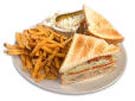|
|
Cuisine Glossary
| You have reached our International Cuisines and information on all aspects of a countries cuisine.
We will try to explain the culture, significant influences, climate, and other factors that have come together to create a distinct style. For example: Spanish, Mexican or Japanese. |
Sandwiches Cuisine
 |
1st Century B.C. -- First recorded sandwich made by rabbi Hillel; he pressed chopped nuts, apples, spices and other ingredients between two matzohs to eat with bitter herbs during Passover.
1762 -- Modern sandwich invented in London by John Montague, fourth Earl of Sandwich, when he asks for bread, cheese and meat to be brought so he can continue gambling. He holds the food -- bread outside and other ingredients inside -- in one hand and keeps playing cards. Other players are said to request the same as Sandwich, giving the sandwich its name and Montague a place in history. 1827 -- The sandwich comes to America in a cookbook by Englishwoman Elizabeth Leslie, who gave a recipe for ham sandwiches as a main dish. 1900 -- Commercial bakeries begin producing loaves of soft white bread for retail sale, fueling interest in sandwiches. By the 1920s, children were carrying sandwiches to school in metal buckets -- the forerunners of lunch boxes. Popular fillings were eggs and ham. 1921 -- White Castle, America's first hamburger chain, opens its first store in Wichita, Kan. 1930 -- Wonder Bread begins selling its soft, white loaves of bread sliced, a product that was so popular it not only revolutionized sandwich-making, it spawned the iconic American phrase, the best thing since sliced bread. Dagwood Bumstead, in the comic strip Blondie, makes it a habit to raid the fridge and construct tall stacks of incompatible fillings between slices of bread. The concoctions came to be called Dagwood sandwiches, a term so well-known it made Webster's New World Dictionary. 1940s -- World War II GIs combine bread, peanut butter and jelly from their meal-kit rations to make a sandwich that came to be known as PB&J. Soldiers continued making the sandwiches even after they returned from the war. Source: HungryMonster Staff Writers. |




